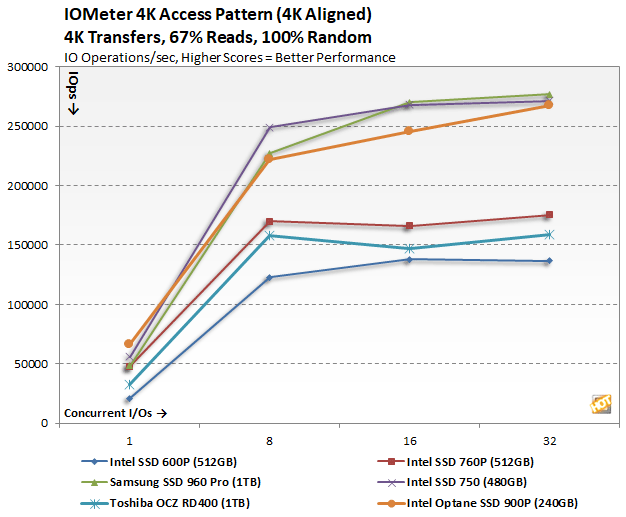Intel SSD 760P Review: Higher Performance, Lower Cost NVMe Storage
Our Test Methods: Under each test condition, the SSDs tested here were installed as secondary volumes in our testbed, with a separate drive used for the OS and benchmark installations. Out testbed's motherboard was updated with the latest BIOS available at the time of publication and AHCI mode was enabled for the host drive.
The SSDs were secure erased prior to testing (when applicable), and left blank without partitions for some tests, while others required them to be partitioned and formatted, as is the case with the ATTO, PCMark, and CrystalDiskMark benchmark tests. Windows firewall, automatic updates, and screen savers were all disabled before testing and Windows 10 Quiet Hours were enabled. In all test runs, we rebooted the system, ensured all temp and prefetch data was purged, waited several minutes for drive activity to settle and for the system to reach an idle state before invoking a test. We should also note that these tests were run on a system without the latest patches for the Spectre and Meltdown security issues installed. Applying those patches has shown to affect storage performance.
|
| Processor - Motherboard - Video Card - Memory - Audio - Storage - |
Intel Core i7-8700K Gigabyte Z370 Ultra Gaming (Z370 Chipset, AHCI Enabled) Intel HD 630 16GB G.SKILL DDR4-2666 Integrated on board Corsair Force GT (OS Drive) Intel Optane SSD 900p (280GB) Inte SSD 750 (480GB) Samsung SSD 960 Pro (1TB) OCZ RD400 (1TB) Intel SSD 600P (512GB) Intel SSD 760P (512GB) |
OS - Chipset Drivers - DirectX - Benchmarks - |
Windows 10 Pro x64 Intel 10.1.1.44, iRST 15.8.1.1007 DirectX 12 IOMeter 1.1 HD Tune v5.70 ATTO v3.05 AS SSD CrystalDiskMark v6.0.0 x64 PCMark Storage Bench 2.0 SiSoftware SANDRA |
|
As we've noted in previous SSD articles, though IOMeter is clearly a well-respected industry standard drive benchmark, we're not completely comfortable with it for testing SSDs. The fact of the matter is, though our results with IOMeter appear to scale, it is debatable whether or not certain access patterns, as they are presented to and measured on an SSD, actually provide a valid example of real-world performance. The access patterns we tested may not reflect your particular workload, for example. That said, we do think IOMeter is a reliable gauge for relative, available IO throughput with a given storage solution. In addition there are certain higher-end workloads you can place on a drive with IOMeter, that you can't with most other storage benchmark tools available currently.
In the following tables, we're showing two sets of access patterns; a custom Workstation pattern, with an 8K transfer size, consisting of 80% reads (20% writes) and 80% random (20% sequential) access and a 4K access pattern with a 4K transfer size, comprised of 67% reads (33% writes) and 100% random access. Queue depths from 1 to 32 were tested, though keep in mind, most consumer workloads usually reside at low queue depths...




|









